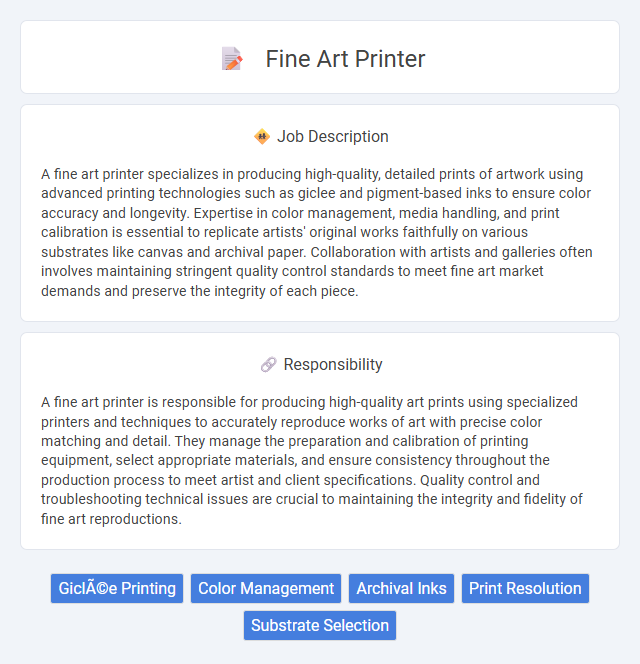
A fine art printer specializes in producing high-quality, detailed prints of artwork using advanced printing technologies such as giclee and pigment-based inks to ensure color accuracy and longevity. Expertise in color management, media handling, and print calibration is essential to replicate artists' original works faithfully on various substrates like canvas and archival paper. Collaboration with artists and galleries often involves maintaining stringent quality control standards to meet fine art market demands and preserve the integrity of each piece.
Individuals with strong attention to detail and a passion for art may likely thrive as fine art printers, as the role demands precision and color accuracy. Those who prefer repetitive tasks without creative engagement might find the job less suitable, given the need for constant quality control and artistic sensitivity. Physical stamina could be important since the job often requires standing for extended periods and handling delicate materials carefully.
Qualification
Fine art printer professionals require expertise in color management, advanced print technologies, and a keen eye for detail to produce high-quality prints that meet gallery and collector standards. Proficiency in using large-format printers, understanding various paper types, and knowledge of archival inks are essential qualifications for ensuring longevity and vibrancy in fine art reproductions. Experience with digital imaging software and a background in art or graphic design further enhance the ability to replicate original artworks precisely.
Responsibility
A fine art printer is responsible for producing high-quality art prints using specialized printers and techniques to accurately reproduce works of art with precise color matching and detail. They manage the preparation and calibration of printing equipment, select appropriate materials, and ensure consistency throughout the production process to meet artist and client specifications. Quality control and troubleshooting technical issues are crucial to maintaining the integrity and fidelity of fine art reproductions.
Benefit
A fine art printer job likely offers significant benefits, including the opportunity to work with high-quality materials and advanced printing technology that enhances artistic expression. There is probable satisfaction in producing museum-quality prints that preserve the integrity of original artworks. This role may also provide a stable income in a niche market with growing demand for custom and limited-edition art reproductions.
Challenge
Fine art printer jobs likely involve the challenge of achieving precise color accuracy and detail reproduction to meet artists' expectations. It is probable that maintaining consistency across various print runs and managing delicate materials requires advanced technical skills and patience. Troubleshooting equipment issues and adapting to evolving printing technologies may also present ongoing obstacles.
Career Advancement
Fine art printer professionals can advance their careers by mastering advanced color management techniques and digital printing technologies, which are essential for producing high-quality, museum-grade prints. Gaining expertise in software like Adobe Photoshop and RIP (Raster Image Processor) systems enhances precision and efficiency, positioning printers for leadership roles or specialized technician positions. Networking with galleries, artists, and collectible print markets further opens opportunities for collaborations and higher-profile projects, driving career growth in the fine art printing industry.
Key Terms
Giclée Printing
Fine art printers specializing in Giclee printing utilize advanced inkjet technology to produce museum-quality reproductions with exceptional color accuracy and longevity. They manage archival pigment inks and high-resolution printers designed for various substrates such as cotton rag paper and canvas, ensuring faithful replication of original artworks. Expertise in color calibration and print finishing techniques is essential to maintain the integrity and value of fine art prints for collectors and galleries.
Color Management
A fine art printer specializing in color management ensures accurate color reproduction by meticulously calibrating printers, monitors, and proofing devices. They work with ICC profiles and implement advanced color separation techniques to match the artist's vision across various substrates. Expertise in color theory and software like Adobe Photoshop and Lightroom is essential to maintain consistency and vibrancy in limited edition prints.
Archival Inks
A Fine Art Printer specializes in producing high-quality prints using archival inks that ensure longevity and color fidelity. Archival inks are pigment-based, providing resistance to fading and environmental damage for decades. This job requires expertise in color management and substrate compatibility to preserve the artwork's integrity over time.
Print Resolution
Fine art printers specialize in producing high-resolution prints that capture intricate details and vibrant colors, essential for preserving the integrity of original artworks. Print resolution, measured in dots per inch (DPI), directly influences the sharpness and clarity of the final product, with professional fine art printers often utilizing resolutions of 1200 DPI or higher. Mastery of print resolution settings ensures the reproduction maintains fidelity, depth, and subtle texture variations critical for gallery-quality prints.
Substrate Selection
Fine art printer professionals prioritize substrate selection to ensure optimal ink adhesion, color accuracy, and longevity of prints, typically choosing high-quality archival papers, canvas, or specialty films designed for fine art reproduction. The choice of substrate impacts the final visual texture and durability, influencing decisions based on the intended display environment and artist specifications. Expertise in substrate characteristics, such as weight, finish, and absorbency, is essential for achieving museum-grade prints with rich detail and color fidelity.
 kuljobs.com
kuljobs.com